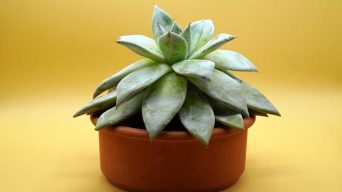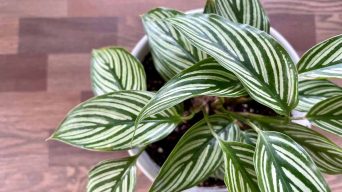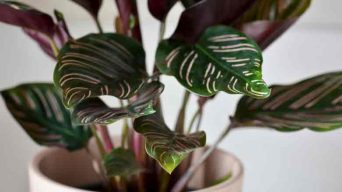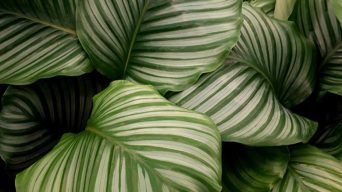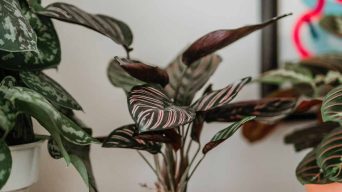Calathea leaves can droop due to water stress, whether it’s caused by underwatering or overwatering. Keeping the soil consistently moist but not waterlogged is essential to maintain their health. You can address humidity levels by misting the plant or using a humidifier. Ensure that your Calathea is not exposed to direct sunlight, which can be harmful. Watch for pests and consider the plant’s adaptation to its new environment.
If you’ve noticed your Calathea leaves start drooping, you’re not alone.
The Calathea, often called the prayer plant, is a popular choice for indoor gardening.
While its striking dark green foliage is admired in many households, the issue of drooping leaves is a common concern for plant owners.
Here, we’ll explore the main causes of Calathea plants drooping and provide effective solutions for each issue.
1. Underwatering
Underwatering is a common cause of drooping foliage in Calathea plants.
Insufficient moisture in the soil prevents the plant from absorbing the necessary hydration, leading to wilting and drooping foliage. This issue is often compounded by high temperatures and low humidity levels, exacerbating water loss from the plant.
To remedy the situation, increase the watering frequency for your Calathea.
A general guideline is to water these plants at least once a week, though adjustments may be necessary in hot or dry weather conditions.
Before watering, check the soil to ensure it is moist but not overly wet or soggy. When watering, provide enough water to saturate the soil thoroughly, reaching the bottom of the pot.
By addressing the underwatering issue and adjusting the watering routine accordingly, you can promote the health and vitality of your Calathea, preventing further drooping of its leaves.
2. Overwatering
Overwatering is a common issue leading to drooping Calathea plants. This occurs when the plant cannot absorb the excess water effectively, resulting in the characteristic droopiness.
In more severe cases, the leaves may exhibit yellowing or brown discoloration.
The key solution to this problem is to adjust the watering frequency.
Calatheas generally require watering once a week, and in cooler, drier conditions, you may extend the interval to two weeks. Assessing the soil moisture before adding more water; the soil should be slightly dry to the touch.
Various methods can help you determine the watering needs of your Calathea.
First, a simple touch test involves inserting your finger into the soil. If it feels wet, refrain from watering.
Alternatively, using a moisture meter can provide precise readings of humidity levels. If the humidity falls below 50%, it’s an indicator that your Calathea may benefit from watering.
Additionally, monitor the water level in the pot. If the water surpasses the soil line, it’s advisable to withhold further watering.
By incorporating these practices and being attentive to the plant’s moisture requirements, you can effectively address and prevent drooping foliage caused by overwatering.
3. Low Humidity
Calatheas, native to tropical rainforests, thrive in high-humidity environments. These indoor plants may experience stress in homes with lower humidity, leading to drooping leaves.
Dry air exacerbates the issue by causing increased water loss from the plant.
Indoor air is typically drier, resulting in the leaves’ edges curling up. The Calathea foliage is particularly sensitive, drooping when humidity falls below 40%.
To address plant drooping caused by low humidity, raise the humidity levels in your home.
Options include using a humidifier, placing the plant near a water source like a fish tank or fountain, or misting the leaves daily. Growing Calathea plants in a terrarium is an alternative to maintaining higher humidity levels.
4. Temperature Stress
Calathea plants are susceptible to temperature changes, leading to drooping leaves. Maintaining an ideal temperature between 65 and 75 degrees Fahrenheit is crucial.
Leaves may droop if the temperature drops below 60 degrees Fahrenheit or rises above 80 degrees Fahrenheit. Fluctuating temperatures can adversely affect Calathea plants, causing their leaves to droop.
Address temperature-related drooping by maintaining a consistent temperature. Use a thermostat to regulate your home’s temperature, or relocate the plant to a room with a more stable climate.
Adjust the plant’s placement to receive direct sunlight by placing it in front of a window or moving it to a shaded area. If temperature consistency is challenging, consider using a grow light to supplement natural light.
5. Light Stress
Calathea foliage may droop due to various reasons associated with light stress.
One primary cause is low light. The plant isn’t receiving adequate light if the leaves stretch towards the light source. To remedy this, relocate the plant to a brighter spot.
On the flip side, excessive direct sunlight can also lead to drooping.
The Prayer plant leaves are delicate and prone to scorching when exposed to direct sunlight, resulting in droopiness. If you notice scorched or browned leaves, it’s a sign to move the plant to a location with indirect or filtered light.
If light stress is causing your plant’s leaves to sag, the solution lies in adjusting its exposure. Calathea plants thrive in bright indirect light, so ensure they are placed where they receive ample natural light.
Alternatively, consider using a grow light to supplement natural light.
If the leaves lean towards the light source, try rotating the plant every few days. This ensures that all leaves receive equal sunlight, promoting balanced growth.
6. Overfertilization
Overfertilization can be a common cause of droopy Calathea plants. When Calathea plants receive excess nutrients, their leaves often exhibit a yellow hue and droop. This occurs because the plant struggles to process the surplus nutrients, leading to stress.
Beyond the visible symptoms of drooping and wilting, overfertilization poses additional risks, including the potential for root rot and other complications.
The primary solution to fix this issue is to cease fertilization altogether. Allow the plant to recover by withholding fertilizer until the leaves return to their normal color. In the meantime, consider flushing the potting soil mix with water to eliminate lingering excess nutrients.
It’s important to note that Calathea plants have modest fertilizer needs. Restrict fertilization to the necessary times, ideally once a month during the growing season, which spans spring and summer.
When you fertilize, opt for a water-soluble fertilizer, using only half of the recommended dosage to prevent overloading the plant with nutrients. This mindful approach ensures the well-being of your Calathea while preventing the issues associated with overfertilization.
7. Adjusting To a New Environment
If you notice your Calathea drooping, it might be acclimating to its new surroundings.
Transplanting or relocating Calathea plants can induce stress as they adapt to the changes in their environment, often resulting in a wilting Calathea and loss of color.
Calatheas are particularly sensitive to variations in light and temperature, and sudden shifts in either can contribute to leaf drooping.
When your Calathea is drooping due to the adjustment phase, the key is patience. Over time, the plant will acclimate to its new environment, and the leaves will regain their usual color.
Consider gradually introducing the plant to its new location to expedite this process. Maintaining consistent temperature and light levels in the new setting can also aid in the adjustment.
With proper plant care, including these measures, Calathea plants will eventually thrive in their new surroundings.
8. Root Rot
If your Calathea appears drooping, it might be due to root rot, a condition triggered by excess moisture that can suffocate and deteriorate the plant’s roots.
This decay prevents the roots from supplying the necessary water and nutrients for the plant’s survival, resulting in drooping leaves that eventually turn brown.
To address this issue promptly, follow these steps:
- Remove from Pot: If you suspect root rot, promptly take the Calathea out of its pot. Examine the roots for signs of decay; they must be removed if they appear black or mushy.
- Allow Drying: Allow the plant to dry out completely before replanting it in fresh soil. This helps prevent further moisture-related issues.
- Replanting: Replant the Calathea in new soil, ensuring the roots are healthy and decay-free. Be cautious not to overwater during this period.
- Moderate Watering: Water the plant sparingly until its roots have fully regenerated. This cautious approach helps prevent a recurrence of excessive moisture and root rot.
Root rot poses a severe threat to Calathea plants, potentially being fatal. Acting swiftly and effectively is crucial if you suspect your plant is affected by this condition.
9. Pest Infestation
If your Calathea is exhibiting signs of drooping, the cause might be a pest infestation. Common culprits include aphids, spider mites, and mealybugs, all of which can target Calatheas.
These pests extract sap from the leaves, resulting in yellowing and leaf loss. Notably, aside from causing leaf drop, pest infestations can pave the way for fungal diseases like powdery mildew and leaf spot.
To address this issue, take proactive measures. Isolate the affected Calathea from other plants to prevent the pests from spreading. Consider treating the infestation with neem oil or insecticidal soap, but follow the instructions diligently.
Dealing with pest infestations can be challenging, often requiring multiple treatments for effective eradication. Ensure the surrounding area is thoroughly cleaned to eliminate lingering eggs or pests.
Swift action is crucial. If you detect a pest infestation early on, it can be treated more easily, contributing to the overall health and vitality of your Calathea.
Final Thoughts
Taking care of your Calathea is straightforward, but there are key considerations to guarantee the well-being and happiness of your indoor plant.
Calatheas thrive in high humidity, making regular leaf misting essential.
To maintain their optimal condition, position your plant in an area with indirect sunlight if it’s placed near a window. Avoid direct sunlight exposure.
Don’t be alarmed if you notice your plant’s leaves starting to droop. Typically, this signals a need for water.
Ensure you thoroughly soak and monitor the plant to prevent recurring issues.
Your attention and a consistent care routine will keep your Calathea flourishing.


